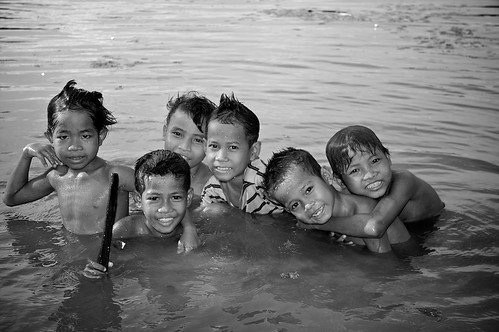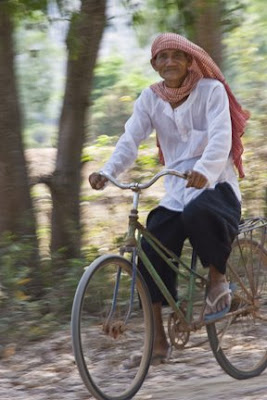LOL this last entry in Nirmal Ghosh’s live-blogging on 14 Apr 2009 upon the Red Shirt leader’s call for an end to the protests:
The reds are dispersing, to rousing music and dousing each other with water to celebrate Songkran. A potentially disastrous situation has been averted.
The Songkran Festival was extended two days, for “cleanup”. [[Straight face: pelt water not tear gas! Smirk, enter stage right.]]] … Kum.ba.ya.my.lord… kum.BA.YAAA…
Thaksin vs the King?
Ousted PM Thaksin Shinawatra
The Yellow Shirts are advocating for a roll-back of “democracy”. From Der Speigel, The King’s Silence (09 Dec 2008):
The airport occupiers and their supporters (Yellow Shirts) are revolting against a democratically elected government whose political base consists of the poor rice farmers of northeastern Thailand. They are leading the fight for a middle-class minority with allegiance to the king and pro-military views, which calls itself the “revolution of the middle class.” If it comes into power, it will do away with democracy and allow only one-third of the representatives of the people to be elected by the people. This comes as no surprise, given the fact the representatives of this segment of society lost the last four elections….
… More and more Thais wonder what the king’s silence means. Could it be a sign of division within the royal family? Queen Sirikit was once spotted at the funeral of a member of the opposition. The Reds, however, hope that the king himself is on their side — that of the poor.
This time Thaksin outright called for the Red Shirts (pro-Thaksin majority rural poor) to dissolve the country into a revolution, and levied accusations against the Privy Council, advisors to the King, for their part in the 2006 coup. Red Shirts rallied behind this call, rushing the parliament house and by the hundreds of thousands incited violent clashes throughout Bangkok and the country. From The Economist, A Right Royal Mess (08 Dec 2008):
The rage of Bangkok’s traditional elite against Mr Thaksin stems partly from embarrassment at having originally supported him…
… Some of Mr Thaksin’s voters must be contemplating the flip-side of the PAD’s (yellow shirts) argument: if the monarchy is against the leader they keep voting for, maybe it is against them. Such feelings may only be encouraged by the PAD’s condescending arguments that the rural poor (Mr Thaksin’s main support base) are too “uneducated” to have political opinions, so their voting power must be reduced.
King Bhumibol Adulyadej
Thailand is experiencing the deep social and ideological divides of a feudal society’s transformation into a modern democracy. The crown’s role as a stabilizing factor in the country’s politics faces its greatest challenge yet. King Bhumibol is widely worshipped as god-like. He facilitated the country’s transition to democracy and has used his considerable influence to arbitrate during periods of political turmoil.
But the crown’s legitimacy may soon see an end, as the King’s health is quickly deteriorating and the next in line for the throne has no command of the hearts of his people. Heir Prince Vajiralongkorn of the patrilineal monarchy lacks the current King’s compassion and devotion to duty, and his suitability for the throne is consistently questioned. One wonders what is in store for Thailand, long the region’s beacon of stability.
Effects on Cambodia?
Regional proverb: When elephants fight, the grass is trampled.
.










